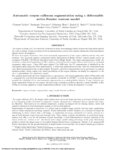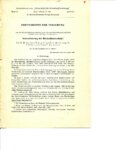TO
| Creator | Title | Description | Subject | Date | ||
|---|---|---|---|---|---|---|
| 701 |
 | Tasdizen, Tolga; Foster, Norman L. | Automatic classification of alzheimer's desease vs. frontotemporal dementia: a spatial decision tree aprroach with FDG-PET | We introduce a novel approach for the automatic classification of FDG-PET scans of subjects with Alzheimers Disease (AD) and Frontotemporal dementia (FTD). Unlike previous work in the literature which focuses on principal component analysis and predefined regions of interest, we propose the combined... | 2008 | |
| 702 |
 | Zhu, Xiaohong | Automatic compensating cleanup operation | Today's part geometries are becoming ever more complex and require more accurate tool path to manufacture. Machining process efficiency is also a major consideration for designers as well as manufacturing engineers. Although the current advanced CAD/CAM systems have greatly improved the efficiency ... | Part geometries | 1989 |
| 703 |
 | Gerig, Guido | Automatic corpus callosum segmentation using a deformable active Fourier contour model | The corpus callosum (CC) is a structure of interest in many neuroimaging studies of neuro-developmental pathology such as autism. It plays an integral role in relaying sensory, motor and cognitive information from homologous regions in both hemispheres. We have developed a framework that allows auto... | 2012-01-01 | |
| 704 |
 | Myers, Chris J. | Automatic derivation of timing constraints by failure analyis | Abstract. This work proposes a technique to automatically obtain timing constraints for a given timed circuit to operate correctly. A designated set of delay parameters of a circuit are first set to sufficiently large bounds, and verification runs followed by failure analysis are repeated. Each ver... | 2002 | |
| 705 |
 | Gooch, Bruce; Shirley, Peter S. | Automatic image creation via artistic composition principles | Methods for choosing image parameters in both art and computer graphics are currently subjective. The choice of parameters results in images of varying quality. One aspect of image quality is the composition of the image. While the principles underlying composition are somewhat subjective, a portion... | Image parameters | 2000 |
| 706 |
 | Tasdizen, Tolga | Automatic markup of neural cell membranes using boosted decision stumps | To better understand the central nervous system, neurobiologists need to reconstruct the underlying neural circuitry from electron microscopy images. One of the necessary tasks is to segment the individual neurons. For this purpose, we propose a supervised learning approach to detect the cell membra... | 2009 | |
| 707 |
 | Lee, Hyo Jong | Automatic mesh analysis technique by knowledge-based system | The finite element analysis technique has been recognized as a very important tool to solve various engineering problems, such as structural analysis, heat transfer, and fluid dynamics. The key point to the technique is discretization of the domain of interest into many finite elements. A good resul... | Mesh analysis; Mesh generation algorithm | 1989 |
| 708 |
 | Shirley, Peter S.; Gooch, Bruce | Automatic painting with economized strokes | We present a method that takes a raster image as input and produces a painting-like image composed of strokes rather than pixels. Unlike previous automatic painting methods, we attempt to use very few brush-strokes. This is accomplished by first segmenting the image into features, finding the medial... | Raster image; Painting-like image; Automatic painting methods | 2000 |
| 709 |
 | Brunvand, Erik L. | Automatic rapid prototyping of semi-custom VLSI circuits using actel FPGAs | Abstract : We describe a technique for translating semi-custom VLSI circuits automatically into field programmable gate arrays (FPGAs) for rapid prototyping to develop a system. Using an array multiplier as an example of this translation, the VLSI circuits are designed using a cell-matrix based envi... | 1995 | |
| 710 |
 | Smith, Kent F. | Automatic rapid prototyping of semi-custom VLSI circuits using FPGAs | We describe a technique for translating semi-custom VLSI circuits automatically, integrating two design environments, into field programmable gate arrays (FPGAs) for rapid and inexpensive prototyping. The VLSI circuits are designed using a cell-matrix based environment that produces chips with densi... | Semi-custom; VLSI circuits | 1994 |
| 711 |
 | Cohen, Elaine | Automatic sculptured five-axis milling with check surfaces | An approach to 5-axis milling of B-spline surfaces is presented. Within its domain, it provides better check surface handling than APT. The scheme for tool position generation is based on a B-spline curve refinement method and a set of criteria for tolerance control which allows the tool positions ... | B-spline surfaces; 5-axis milling; Tool paths | 1989 |
| 712 |
 | Fuchs, Henry | The automatic sensing and analysis of 3-D surface points from visual scenes | Described are the design and implementation of a new range-measuring sensing device and an associated software algorithm for constructing surface descriptions of arbitrary three-dimensional objects from single or multiple views. The sensing device, which measures surface points from objects in its ... | Range-measuring; Sensing device | 1976 |
| 713 |
 | Stevens, Kenneth; Davis, Alan L. | Automatic synthesis of fast compact self-timed control circuits | We present a tool called MEAT which has been designed to automatically synthesize transistor level. CMOS, self-timed control circuits. MEAT has been used to specify and synthesize self-timed circuits for a fully self-timed 300,000 transistor communication coprocessor. The design is specified using f... | 1993 | |
| 714 |
 | Stevens, Kenneth | Automatic synthesis of fast, compact self-timed control | An automated synthesis tool, called the Most Excellent Asynchronous Tool, or MEAT is presented. This tool has been used to specify and synthesize self-timed circuits for a fully self-timed 300,000 transistor communication co-processor. The Specification is done with stylized state diagrams. This is ... | 1992 | |
| 715 |
 | Riloff, Ellen M. | Automatically constructing a dictionary for information extraction tasks | Knowledge-based natural language processing systems have achieved good success with certain tasks but they are often criticized because they depend on a domain-specific dictionary that requires a great deal of manual knowledge engineering. This knowledge engineering bottleneck makes knowledge-based ... | Information extraction; Dictionary construction; Knowledge-based systems; AutoSlog; Domain-specific dictionary | 1993 |
| 716 |
 | Freire, Juliana | Automatically extracting form labels | We describe a machine-learning-based approach for extracting attribute labels from Web form interfaces. Having these labels is a requirement for several techniques that attempt to retrieve and integrate data that reside in online databases and that are hidden behind form interfaces, including schema... | Learning classifiers | 2008 |
| 717 |
 | Riloff, Ellen M. | Automatically generating extraction patterns from untagged text | Many corpus-based natural language processing systems rely on text corpora that have been manually annotated with syntactic or semantic tags. In particular, all previous dictionary construction systems for information extraction have used an annotated training corpus or some form of annotated input... | Information extraction; Automatically generating; Extraction patterns; Untagged text; Corpus-based; AutoSlog-TS; AutoSlog system; MUC-4; Dictionary construction | 1996 |
| 718 |
 | Davis, Al | Automating the design of embedded domain specific accelerators | Domain specific architecture (DSA) design currently involves a lengthy process that requires significant designer knowledge, experience, and time in arriving at a suitable code generator and architecture for the target application suite. Given the stringent time to market constraints and the dyna... | Domain specific architecture; Stall cycle analysis; SCA; Domain specific accelerators | 2008 |
| 719 |
 | Neatrour, Anna; Morrow, Anne; Rockwell, Kenneth W.; Witkowski, Alan J. | Automating the production of map interfaces for digital collections using Google API's | Many digital Libraries are interested in taking advantage of the GIS mapping capabilities provided by GoogLe Maps and GoogLe Earth. The DigitaL Ventures Division of the University of Utah J. Willard Marriott Library has successfully completed an innovative automated process in which descriptive me... | digital libraries, gis, geocoding, maps, KML, Graphical user interfaces, Google Maps | 2011 |
| 720 |
 | Gardner, Reed M. | Automatisierung der Herzkathetertechnik | Biomedical Informatics | 1970 | |
| 721 |
 | Sobh, Tarek M. | Autonomous Observation | We address the problem of observing an agent. We advocate a modeling approach for the visual system and its observer, where a discrete event dynamic system (DEDS) framework is developed and "events" are defined as ranges on parameter subsets. The dynamic recursive context for finite state machines (... | Observation; Manipulation process | 1992 |
| 722 |
 | Sobh, Tarek M. | Autonomous observation | We address the problem of observing an agent?? We advocate a modeling approach for the visual system and its observer where a discrete event dynamic system DEDS framework is developed and events are de ned as ranges on parameter subsets?? The dynamic recursive context for nite state machine... | Autonomous observation | 1992 |
| 723 |
 | Digre, Kathleen B.; Gouw, Launce G.; Harris, Catherine P.; Haines, John H.; Ptacek, L.J. | Autosomal dominant cerebellar ataxia with retinal degeneration: clinical, neuropathologic, and genetic analysis of a large kindred. | The autosomal dominant cerebellar ataxias (ADCA) comprise a heterogeneous group of neurologic disorders characterized by degeneration of the cerebellum, spinal cord, and brainstem. Genetic analysis has revealed two loci, SCA1 on chromosome 6p, and SCA2 on chromosome 12q, responsible for some ADCA. W... | Retinal Degeneration; Cerebellar Ataxia; Genetic Analysis | 1994-08 |
| 724 |
 | Baehr, Wolfgang; Katz, Bradley J.; Creel, Donnell J.; Zhang, Kang | Autosomal dominant cone dystrophy caused by a novel mutation in the GCAP1 gene (GUCA1A) | PURPOSE: To describe the clinical features and genetic analysis of a family with an autosomal dominant cone dystrophy (adCD). METHODS: Selected members of a family with an autosomal dominant cone dystrophy underwent ophthalmic evaluation. Blood samples were obtained, genomic DNA was isolated, and ge... | Mutation, Missense; DNA Mutational Analysis; Electroretinography | 2005 |
| 725 |
 | Carter, John B. | The avalanche myrinet simulation package | This is a user manual for version 2.0 of the Myrinet simulation package. Users of the V2.0 package can specify arbitrary network topologies composed of Myrinet switches with different number of ports. For example, 4-port and 32-port switches can be used in a single system. Because the V2.0 model sup... | Avalanche Myrinet; Simulation Package; User manual; Myrinet switches; port switches | 1996 |
